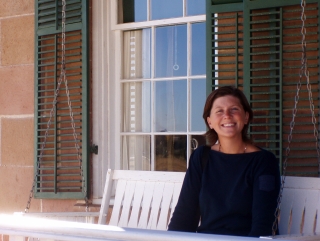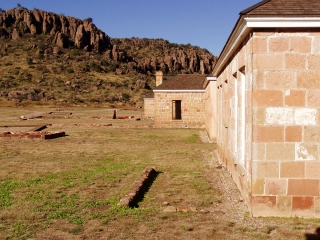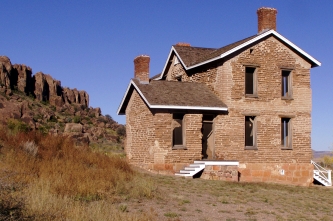Fort Davis National Historic Site
Fort Davis, Texas
Visited: November 17, 2004
NPS Site Visited: 116 of 353
NPS Website; Local Website
 WHAT IS IT? WHAT IS IT?
Southwest Texas fort, commissioned from 1854 to 1891, whose purpose was to protect the San-Antonio-El Paso road from Indian raids. African American cavalry units, nicknamed Buffalo Soldiers, served at Fort Davis from 1867 until its closing.
BEAUTY (5/10)
Fort Davis NHS is a relatively well-preserved example of a 19th-century fort. Many of the redbrick, black roofed buildings are still standing, while their interiors have been restored and refurbished by the National Park Service. Other structures stand in various stages of ruin.
Fort Davis enjoys a striking setting lying below 200-foot high rock canyon walls lined with prickly pear cacti. The landscape is rough and rugged; you feel like you are at the edge of the West. Fort Davis is the highest town in Texas. It is all down hill from here.
HISTORIC SIGNIFICANCE (4/10)
Fort Davis saw the first government sanctioned military action by African American citizens. The post-Civil War 1866 “Act to Increase and Fix the Military Peace Establishment of the United States” opened an official place in the military for black Americans. The first black regiments were the Ninth and Tenth Cavalry. Their first post was at Fort Davis, ironically named, pre-Civil War, for Confederate States of America President Jefferson Davis.
All other historical aspects of Fort Davis NHS are rather mundane and trumped by other National Park Service forts. The Buffalo Soldiers make the Site a unique and important American place and it is a shame that they do not receive top billing.
CROWDS (6/10)
A few other tourists ambled around the Fort’s grounds during our visit. Because there are no tours, our interaction was limited; at no time were we near each other. As we were about to leave, we overheard two men in the bookstore discussing the titles. They were clearly hardcore Civil War buffs. We could have benefited from their knowledge had there been a Ranger talk.
 EASE OF USE/ACCESS (1/5) EASE OF USE/ACCESS (1/5)
Fort Davis NHS is a long way from nowhere. El Paso lies 206 miles to the northwest; Odessa is 158 miles to the northeast. A detour off Interstate 10 will cost you about 60 miles. West Texas is a big place.
CONCESSIONS/BOOKSTORE (4/5)
Ladies’ bonnets of every size and calico pattern are tempting to try on. Replica badges and medals would easily catch a young boy’s eye, as would wooden toys and games. The selection of books is good, not great. Books on Buffalo Soldiers were standard titles we had seen repeated at other Parks. The memory and history of these black military units were underrepresented in the one National Park that is supposed to give them ample space and recognition.
COSTS (3/5)
Admission is $3 per person, 16 and under gets in free. Entry is also free if you have the National Parks Pass.
RANGER/GUIDE TO TOURIST RATIO (2/5)
The Site’s interpretive staff consists of only three Rangers. There are no Ranger talks except during special events.
TOURS/CLASSES (3/10)
The Site’s introductory video is odd. The script is needlessly wordy and scholarly. It uses far too many big words and is detached from helpfulness in a professorial way.
The film’s narrator...you will never guess. NBA All-Time leading scorer Kareem Abdul-Jabbar dressed in full cowboy costume. When he first appeared, we balked, “that can’t be, can it?” Not that it wasn’t obviously Kareem, but why in blazes would he be narrating the video for a remote west Texas park. Thankfully, a superimposed name appeared on screen confirming our suspicion. It was him. He has been here too!
Kareem seemed just as frustrated with the script as we were. Confused at why the compelling story of the Buffalo Soldiers takes back seat to the humdrum info about the guarding of the El Paso Road.
The Park’s museum still displays the 40-year old Mission ’66-era exhibits. A mimeographed historical update is available on most of the displays. As in, “here’s what they said then, here is what we have learned”. Faced with dated exhibits and no promise of a new museum, it is an admirable solution.
The change undertaken by the Buffalo Soldiers display is especially fascinating. The exhibit has almost tripled in size and now includes a life-sized mannequin. The original display refers to the soldiers as “negroes” with “kinky hair”, showcases more pictures of the white commanding officers than the Buffalo Soldiers themselves and gives the units’ military credit to the aforesaid white officers. Why is the demeaning and offensive original display still in the museum? It adds little to the expanded exhibit. The National Park Service should remove this historical misrepresentation.
A touch-screen computer stands in a corner of the museum. It includes a wealth of information on all things Fort Davis. We have found that these computers are often accompanied by a notable lack of Ranger talks and human interpretive help. This Site was no exception. If we wanted to learn solely through a computer program, we would have stayed home and purchased an Encyclopaedia Britannica CD-Rom. (or just gone on the wiki)
 FUN (4/10) FUN (4/10)
Fort Davis NHS gave us a chance to get out of the car and stretch our legs after hours of driving across forgettable landscapes. Both the film and the museum were disappointing.
We read in the park pamphlet that there are costumed Rangers and volunteers that give living history presentations on the grounds during the season, which we guessed meant summer. The Ranger on duty corrected our assumptions – there are actually several seasons at the Fort, one for tourists, one for school groups, and one for winter Texans, which we are learning is the regional term for retirees who spend their winters in warm, southern climates a.k.a. snowbirds.
Costumed interpretations are not a given in any season – only when staffing allows. During our visit, there was no ability to interact with history other than walking the perimeter of the fort’s grounds and peeking through the thick glass which separated us from the few furnished officers’ rooms. Not that fun.
WOULD WE RECOMMEND? (4/10)
Fort Davis is probably our least favorite of the western forts that we have seen. There is nothing there that necessitates the long drive which separates it from nearby cities and amenities. If more emphasis were placed on improving the Buffalo Soldier portion of the Site, this rating could improve. A guest spot of Kareem Abdul-Jabaar on the Site’s video just isn’t enough.
TOTAL 36/80
|